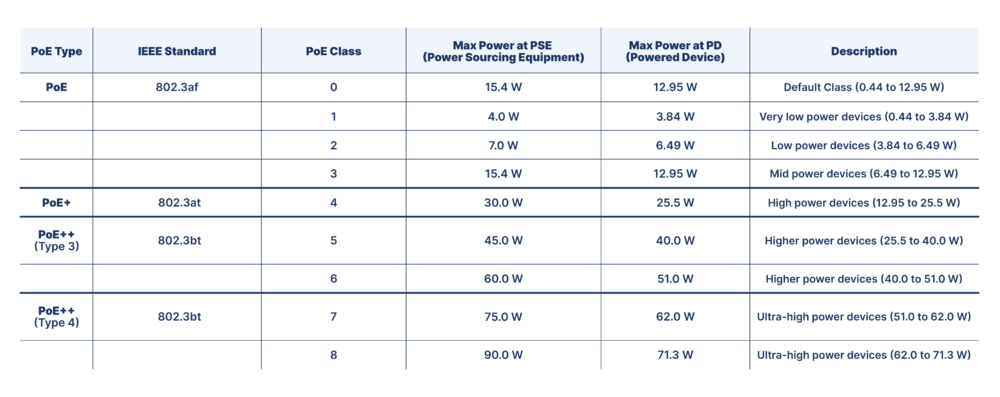Active vs Passive PoE
Summary
The article compares Active and Passive Power over Ethernet (PoE). Active PoE, compliant with IEEE standards, automatically negotiates power delivery between the source and the device, ensuring safe and appropriate power levels. In contrast, Passive PoE delivers a constant voltage without negotiation, requiring manual matching of the power source to the device's requirements. While Active PoE is safer and more flexible, Passive PoE is simpler and more cost-effective for compatible devices, highlighting the importance of understanding the correct and incorrect usage to avoid damage.
Note: The following recommendations apply to Teltonika-Networks devices
Active PoE
How Active PoE Works
Active Power over Ethernet (PoE) is a technology that allows Ethernet cables to carry electrical power, along with data, to remote devices. Active PoE follows specific IEEE standards (802.3af, 802.3at, and 802.3bt) that ensure safe and efficient power delivery. Here’s a step-by-step explanation of how Active PoE works:
1. Detection: The Power Sourcing Equipment (PSE) sends a small voltage to detect a compatible Powered Device (PD).

2. Classification: The PSE classifies the PD by sending a higher voltage to determine its power requirements.

3. Power-Up: The PSE gradually increases the voltage to the required level.

4. Power Delivery: Power and data are transmitted simultaneously over the Ethernet cable. The PSE continuously monitors the power supply to ensure safe and #stable operation.


Key Points
- PoE (IEEE 802.3af): Provides up to 15.4 W of DC power.
- PoE+ (IEEE 802.3at): Provides up to 30 W of DC power.
- PoE++ (IEEE 802.3bt): Extends the power up to 60 W (Type 3) and up to 90 W (Type 4).
Each class within these standards specifies the maximum power that can be delivered to a powered device (PD), and the maximum power that can be drawn from the power sourcing equipment (PSE), ensuring compatibility and efficient power management across various devices and applications.
Passive PoE
How Passive PoE Works
Passive PoE (Power over Ethernet) is a non-standard implementation of PoE that provides power to network devices without adhering to the IEEE PoE standards. Unlike Active PoE, which involves power negotiation and safety protocols, Passive PoE supplies a fixed voltage directly to the connected devices. This simplicity makes Passive PoE cheaper and easier to implement, but it comes with certain risks and limitations.
Key Features of Passive PoE
- Fixed Voltage: Passive PoE typically provides a fixed voltage, usually 12V, 24V, or 48V.
- No Power Negotiation: Devices do not negotiate the power they receive, so the voltage is always constant.
- Simpler Implementation: Less complex circuitry is needed compared to Active PoE.
- Risk of Damage: If the supplied voltage does not match the device's requirements, it can damage the device.
Correct and Incorrect Ways of Using Passive PoE
Correct Way
- Voltage Matching: Ensure that the voltage supplied by the Passive PoE injector matches the voltage required by the device.
- Device Compatibility: Use Passive PoE with devices specifically designed to accept the supplied voltage without power negotiation.
- Proper Installation: Follow proper wiring practices and use quality cables to ensure stable power delivery.
- Avoid High Power Devices: Use Passive PoE for low power devices like small access points, cameras, or VoIP phones that are within the power capacity of the PoE injector.

Incorrect Way
- Mismatched Voltage: Connecting a device to a Passive PoE injector that supplies a higher voltage than the device is designed for, leading to potential damage.
- Incompatible Devices: Using Passive PoE with devices that require IEEE 802.3af/at/bt compliant power negotiation, which can lead to malfunction or damage.
- Overloading: Attempting to power devices that require more power than what the Passive PoE can provide, causing inadequate performance or device failure.
- Improper Wiring: Using substandard or incorrect wiring that can lead to power loss, instability, or even safety hazards.

Use Case Summary
- Passive PoE: Simplifies power delivery by providing a fixed voltage but lacks safety and negotiation features of Active PoE.
- Correct Usage: Ensure voltage and device compatibility, use proper wiring, and stick to low power devices.
- Incorrect Usage: Avoid mismatched voltages, incompatible devices, overloading, and improper wiring to prevent damage and ensure reliable operation.
Using Passive PoE appropriately can be cost-effective and straightforward, but it requires careful consideration of device requirements and proper installation practices to avoid potential risks.
Key Differences Between Active and Passive PoE
Active PoE
- Standards: Follows IEEE standards (802.3af, 802.3at, 802.3bt).
- Power Delivery: Uses a negotiation process to determine and supply the correct power level to devices.
- Voltage: Typically delivers 48V DC, but can vary based on device classification.
- Complexity: More complex and sophisticated system with power negotiation and monitoring.
- Compatibility: Suitable for a wide range of devices with varying power requirements.
- Safety: Ensures safe and efficient power delivery by regulating voltage and current.
- Examples: Used in devices like IP cameras, wireless access points, and VoIP phones.
Passive PoE
- Standards: Non-standardized, does not follow IEEE standards.
- Power Delivery: Supplies a fixed voltage (e.g., 12V, 24V, 48V) directly through the Ethernet cable without negotiation.
- Voltage: Fixed voltage delivery without adjustment based on device needs.
- Simplicity: Simpler and less expensive to implement compared to Active PoE.
- Compatibility: Limited to devices that specifically support the fixed voltage provided.
- Risk: Higher risk of damaging devices if the voltage supplied does not match device requirements.
- Examples: Commonly used to power up some of the Teltonika devices.
Key Differences Sumarry Between Active and Passive PoE
Active PoE is standardized, involves power negotiation for precise delivery, and supports a wide range of devices. In contrast, Passive PoE delivers a fixed voltage without negotiation, offering simplicity and lower cost but with increased risk of compatibility issues and potential device damage if not properly matched.
